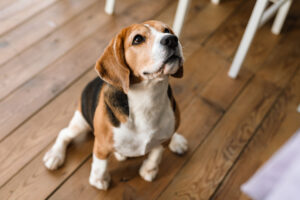Training your furry friend to do their business in the correct place is among the first and most crucial steps in your journey as a pet parent. It’s not just about keeping your home clean and odor-free; it’s about instilling good habits in your pup, ensuring their well-being, and fostering a harmonious living environment. This process, while sometimes challenging, is a significant opportunity to bond with your dog and understand their needs better.
The key to success lies in patience and consistency. Dogs learn best through repetition and positive reinforcement. Remember, every pup is unique; some may pick up on training quickly, while others may need a bit more time and encouragement. Regardless of the pace, what’s important is establishing a clear, loving, and persistent training regimen.
In this comprehensive guide, we’ll walk you through everything you need to know about teaching your dog to relieve themselves in the right spot. From understanding your dog’s natural instincts to employing effective training techniques and tackling common challenges, we’ve got you covered. So, let’s embark on this journey together and lay the foundation for a happy, healthy relationship with your four-legged family member.

Close up of a beagle dog sitting indoors, looking up
Understanding Your Dog’s Needs
Understanding your dog’s biological needs is the cornerstone of successful potty training. By recognizing the signs that your dog needs to go and adjusting to their physical capabilities, you create a foundation for effective communication and training. Here’s how to align your expectations with your dog’s natural abilities and signals.
Recognizing the Signs
Dogs often exhibit certain behaviors when they need to relieve themselves. These signs can include sniffing around, circling, whining, barking, or heading towards the door. Young puppies, especially, may show sudden bursts of energy or become unusually distracted. Observing your dog closely and learning these signals is crucial, as timely response can prevent accidents and reinforce training.
Impact of Age on Bladder Control
Puppies have limited bladder control and may need to go outside every hour, including during the night. As a general rule, a puppy can hold their bladder for one hour for every month of age, up to about 8 months. This means a 3-month-old puppy might need a break every three hours. Adult dogs, on the other hand, typically need to go outside three to five times a day. Understanding this will help you tailor your training and expectations to your dog’s developmental stage.
Importance of a Feeding Schedule
Establishing a consistent feeding schedule plays a vital role in potty training. Feeding your dog at the same times every day helps regulate their digestion and predict when they’ll need to go outside. Avoid free-feeding, where food is available all the time, as this can make it harder to anticipate their needs. Instead, opt for two to three set meal times a day, depending on your dog’s age and health recommendations from your vet. Remember, what goes in on a schedule comes out on a schedule, making it easier for you to manage and anticipate potty breaks.
By understanding these aspects of your dog’s needs, you’re better equipped to guide them through the potty training process. It’s not just about teaching them where to go but understanding why they need to go and when. This understanding fosters a deeper bond between you and your dog, as you become more attuned to their needs and ways of communicating.

Setting Up for Success
Creating an environment conducive to learning is essential for potty training your dog. Whether you’re designating an outdoor spot or setting up an indoor area for younger puppies or apartment-dwelling dogs, preparation is key. Here’s how to choose the right spot and make it appealing to your dog.
Choosing the Right Spot
Outdoors: For most dog owners, teaching their dog to relieve themselves outdoors is the goal. Select a spot that is easily accessible but away from heavy foot traffic to give your dog some privacy. Consistency is crucial; always take your dog to the same spot so they can associate that specific area with going to the bathroom. Over time, the scent will signal to your dog that it’s the designated potty area.
Indoors: If you’re raising a puppy in an apartment or need an indoor option for other reasons, choose a specific corner or area for your dog’s potty spot. This could be a balcony or a part of a bathroom. Use puppy pads or an indoor potty grass tray to delineate this area clearly. Make sure it’s a spot that’s easy to clean and not used for any other purpose.
Making the Area Appealing
To encourage your dog to use the designated spot, you might need to make it appealing. For outdoor spots, natural grass is usually attractive enough for dogs. However, if you’re dealing with a stubborn or hesitant dog, try using a small amount of their urine or feces to scent the area initially. This can help them recognize the spot as a bathroom area.
For indoor spots, puppy pads come with a scent designed to attract dogs. If using a grass tray, ensure it’s always clean but not overly sanitized at first, so it retains a slight scent that encourages your dog to use it.
Tools and Supplies
- Puppy Pads: Essential for indoor training, offering a clear, designated spot for your dog to relieve themselves.
- Enzymatic Cleaners: Accidents will happen. Enzymatic cleaners break down stains and odors at the molecular level, eliminating traces of accidents and preventing your dog from being attracted back to the wrong spots.
- Treats for Rewards: Having treats on hand to reward immediate successful behavior is crucial for reinforcing positive actions.
- Crate: A crate can be a helpful tool in potty training, as dogs naturally avoid soiling their sleeping area. It can help teach bladder control when used appropriately.
Setting up for success in potty training involves not just the physical space but also preparing yourself with the right tools and mindset. Patience, consistency, and the right equipment can make the training process smoother for both you and your dog.

Training Techniques
Successfully guiding your dog to reliably use their designated potty area hinges on effective training techniques. This journey, filled with patience and consistency, can be made smoother with the right approaches. Below are tried-and-true methods to encourage your dog to go to the bathroom in the right place.
Positive Reinforcement and Rewards
The cornerstone of dog training, especially for potty training, is positive reinforcement. This involves rewarding your dog for good behavior — in this case, using their designated potty area. Rewards can come in various forms, such as treats, praise, or playtime, immediately after they’ve done their business in the correct spot. The key is to make the reward immediate and desirable, reinforcing the connection between the action and the positive outcome in your dog’s mind.
Establishing a Routine
Dogs thrive on routine, and establishing a strict potty schedule is crucial. Take your dog to their potty area:
- First thing in the morning,
- Last thing at night,
- Shortly after each meal,
- And every 1-2 hours in between, depending on their age and bladder control.
Consistency helps your dog learn when and where it’s appropriate to go. Over time, they’ll begin to anticipate these outings and hold their bladder accordingly.
Dealing with Accidents
Accidents are an inevitable part of potty training, but how you handle them can significantly impact your dog’s learning. Never punish your dog for accidents; they’re likely not to understand and may become fearful or anxious, which can hinder training progress. Instead, clean up accidents promptly with an enzymatic cleaner to remove the scent and discourage your dog from returning to that spot. If you catch your dog in the act, calmly interrupt them and immediately take them to their potty area to finish.
Crate Training as an Aid
For many dogs, a crate is a safe, personal space. Because dogs naturally avoid soiling their den, a crate can be a powerful tool in teaching bladder control. Crate training should be done gradually, ensuring the crate is a positive, comfortable place for your dog. Never use the crate as punishment. If used correctly, a crate encourages a dog to hold their bladder until they’re taken outside to their potty area.
Gradually Expanding the Dog’s “Allowed” Areas
Start by keeping your dog in a confined space or room where you can monitor them closely for signs that they need to go. As they become more reliable in using their potty area, gradually give them access to more of the house. This method teaches them that the rules apply everywhere, not just in their immediate vicinity.
Implementing these training techniques with patience and consistency will set the foundation for a well-behaved dog. Remember, every dog is unique, and what works for one may not work for another. It’s essential to be flexible and adapt your approach to fit your dog’s individual needs and personality.

